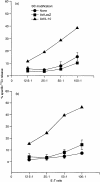Contrasting effects of myeloid dendritic cells transduced with an adenoviral vector encoding interleukin-10 on organ allograft and tumour rejection
- PMID: 11012777
- PMCID: PMC2327075
- DOI: 10.1046/j.1365-2567.2000.00096.x
Contrasting effects of myeloid dendritic cells transduced with an adenoviral vector encoding interleukin-10 on organ allograft and tumour rejection
Abstract
Mouse bone marrow-derived myeloid dendritic cells (DC) propagated in granulocyte-macrophage colony-stimulating factor and transforming growth factor-beta1 (TGF-beta1) (so-called 'TGF-beta DC') are phenotypically immature, and prolong allograft survival. Interleukin-10 (IL-10) has been shown to inhibit the maturation of DC by down-regulating surface major histocompatibility complex (MHC) class II, co-stimulatory and adhesion molecule expression. Genetic engineering of TGF-beta DC to overexpress IL-10 might enhance their tolerogenic potential. In this study, adenoviral (Ad) vectors encoding the mouse IL-10 gene were transduced into B10 (H2b) TGF-beta DC. Transduction with Ad-IL-10 at a multiplicity of infection (MOI) of 50-100 resulted in a modest reduction in the incidence of DC expressing surface MHC class II, CD40, CD80 and CD86. Paradoxically, Ad-IL-10 transduction enhanced the allostimulatory activity of DC in mixed leucocyte reactions and cytotoxic T lymphocyte assays, and increased their natural killer cell stimulatory activity. Systemic injection of normal C3H recipients with Ad-IL-10-transduced B10-DC 7 days before organ transplantation, exacerbated heart graft rejection and augmented circulating anti-donor alloantibody titres. Contrasting effects were observed in relation to tumour growth. All mice preimmunized with Ad-IL-10-transduced, tumour antigen (B16F10)-pulsed DC developed palpable tumours, associated with significant inhibition of splenic anti-tumour cytotoxic T lymphocyte generation. Animals pretreated with control Ad-LacZ-transduced, B16F10-pulsed DC however, remained tumour free. These findings are consistent with the multifunctional immunomodulatory properties of mammalian IL-10.
Figures








Similar articles
-
Retroviral delivery of transforming growth factor-beta1 to myeloid dendritic cells: inhibition of T-cell priming ability and influence on allograft survival.Transplantation. 2002 Jul 15;74(1):112-9. doi: 10.1097/00007890-200207150-00019. Transplantation. 2002. PMID: 12134108
-
Phenotype, function, and in vivo migration and survival of allogeneic dendritic cell progenitors genetically engineered to express TGF-beta.Transplantation. 1998 Dec 27;66(12):1810-7. doi: 10.1097/00007890-199812270-00040. Transplantation. 1998. PMID: 9884280
-
Blockade of the CD40-CD40 ligand pathway potentiates the capacity of donor-derived dendritic cell progenitors to induce long-term cardiac allograft survival.Transplantation. 1997 Dec 27;64(12):1808-15. doi: 10.1097/00007890-199712270-00031. Transplantation. 1997. PMID: 9422424
-
Dendritic cells transduced with viral interleukin 10 or Fas ligand: no evidence for induction of allotolerance in vivo.Transplantation. 2002 Jan 15;73(1 Suppl):S27-30. doi: 10.1097/00007890-200201151-00010. Transplantation. 2002. PMID: 11810058 Review.
-
Converting nonhuman primate dendritic cells into potent antigen-specific cellular immunosuppressants by genetic modification.Immunol Res. 2002;26(1-3):297-302. doi: 10.1385/ir:26:1-3:297. Immunol Res. 2002. PMID: 12403367 Review.
Cited by
-
Overexpression of Jagged-1 combined with blockade of CD40 pathway prolongs allograft survival.Immunol Cell Biol. 2015 Feb;93(2):213-7. doi: 10.1038/icb.2014.84. Epub 2014 Oct 7. Immunol Cell Biol. 2015. PMID: 25287443
-
Dendritic cells exposed in vitro to TGF-beta1 ameliorate experimental autoimmune myasthenia gravis.Clin Exp Immunol. 2002 Feb;127(2):214-9. doi: 10.1046/j.1365-2249.2002.01748.x. Clin Exp Immunol. 2002. PMID: 11876742 Free PMC article.
-
Tolerance through Education: How Tolerogenic Dendritic Cells Shape Immunity.Front Immunol. 2017 Dec 11;8:1764. doi: 10.3389/fimmu.2017.01764. eCollection 2017. Front Immunol. 2017. PMID: 29375543 Free PMC article. Review.
-
Transcriptomic Analysis Identifies A Tolerogenic Dendritic Cell Signature.Front Immunol. 2021 Oct 20;12:733231. doi: 10.3389/fimmu.2021.733231. eCollection 2021. Front Immunol. 2021. PMID: 34745103 Free PMC article.
-
Effect of immune tolerance induced by immature dendritic cells and CTLA4-Ig on systemic lupus erythematosus: An in vivo study.Exp Ther Med. 2018 Mar;15(3):2499-2506. doi: 10.3892/etm.2018.5697. Epub 2018 Jan 4. Exp Ther Med. 2018. PMID: 29456655 Free PMC article.
References
-
- Steinman RM. The dendritic cell system and its role in immunogenicity. Annu Rev Immunol. 1991;9:271–96. - PubMed
-
- Austyn JM. The initiation of immune responses and allograft rejection. In: Rose ML, Yacoub MH, editors. Immunology of Heart and Lung Transplantation. Boston: Little, Brown; 1993. pp. 22–41.
Publication types
MeSH terms
Substances
Grants and funding
LinkOut - more resources
Full Text Sources
Other Literature Sources
Research Materials

